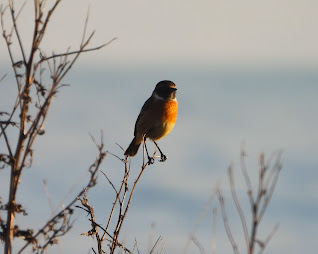It's a pity the weather in the middle weeks of October was so rubbish as one of my junior buddleia bushes actually produced a couple of decent sprigs during that period that could potentially have attracted a late butterfly or two.
 |
| Buddleia - the last blooms |
Anyway persistent rain meant it wasn't to be. The last butterfly I saw passed over the car park at Washington Sports Centre on 20th October. It was brown so presumably a small tortoiseshell or comma, I couldn't tell.
One nice surprise was however a visit from a tree sparrow to the reduced offerings in the feeders. Not a rare but nevertheless an infrequent occurrence.
 |
| Tree Sparrow |
As you can maybe tell, it proved to be a bit of a poser.
After various postponements, we decided that the monsoon season was finally over at the weekend and I drove over to Alex and Vicki's for a visit to the massive reed bed on the River Tay between Port Allen and Errol. The key target, the bearded tit, is supposed to inhabit the area but we didn't really rate the chances of success. In particular I reckoned bearded tits might not fancy the extreme cold that can be experienced north of the Firth of Forth. In fact it turned out to be a lovely day. The trees were at their most colourful and bathed in sunshine.
After a fleeting encounter with a red squirrel, Vicki thought she heard some bearded tits. Then, on a pathway out through the reeds, we hit gold. I saw one straight away but wasn't totally sure. A twitcher turned up, himself sporting a magnificent russet beard, and soon they - the tits - were all over the place, at least a good few dozen of them.
We were snapping away busily as they mostly didn't stay in the same place for long. And I was quite pleased that I even managed a couple of videos with my fancy new camera.
Bearded Tits
I realise there may have been some unconscious gender bias going on there as I seem to have zoomed in on the males, so here in the interests of balance are a couple of shots of the females.
 | | Female Bearded Tit |
|  | | Female Bearded Tit? |
|
As you can see and maybe would have expected, they are clean shaven. We did wonder though whether the second one might be a juvenile. It was the first time I have seen bearded tits since I visited Minsmere 12 years ago.
After a most pleasant session and no sign of a marsh harrier, we gave ourselves the 'job done' sticker, and spurning the chance to pursue a mandarin duck at Scone, we headed south for Loch Leven.
This was actually a good deal less rewarding as there wasn't too much going on in the first hide we visited and by the time we got to the second hide, the light was getting tricky so that I, at least found it tricky to see the colouration of the ducks.
In fact the best shots I got weren't of ducks at all:
 | | Stonechat |
|  | Little Egret
|
|
The others we observed were a lot of coots, some teal, wigeon and a few goldeneye.
I was a bit disappointed not to see any pink footed geese as there had been plenty around but days earlier and, on trying to perform alchemy on some distant greylags with the camera, I can now see that I actually captured a few whooper swans even further away. The shot is unfortunately too blurry to publish - even on here!
Otherwise I did dryly remark that there was more wildlife on the steps going down to the trails - which you actually can't see on descending them.
 |
| The wildlife steps |
Another visual did however catch my interest though. It was a sign on the butterflies and moths present, which included a picture of a small blue. Clearly a strong case for a revisit one summer...
There's an interesting sequel to our trip of a non-nature variety. As we got ready to go home from Loch Leven, I wanted to check a couple of sightings on my mobile phone and discovered to my horror that I no longer had it. Vicki and Alex phoned it several times and got a ringing tone and I realised I had probably lost it somewhere on the woodland trail by the Tay earlier.
As we drove back there frantically to beat the dusk, Vicki got a call from Mr Huang, a (we think) Chinese tourist who'd picked it up and were able to meet him as he reached his airbnb in Errol. Apparently he'd heard the alarm going off that I had set to remind me to text a friend.
Bearded tits AND getting a phone back you lost on a woodland trail! How much luckier can I get?


















































